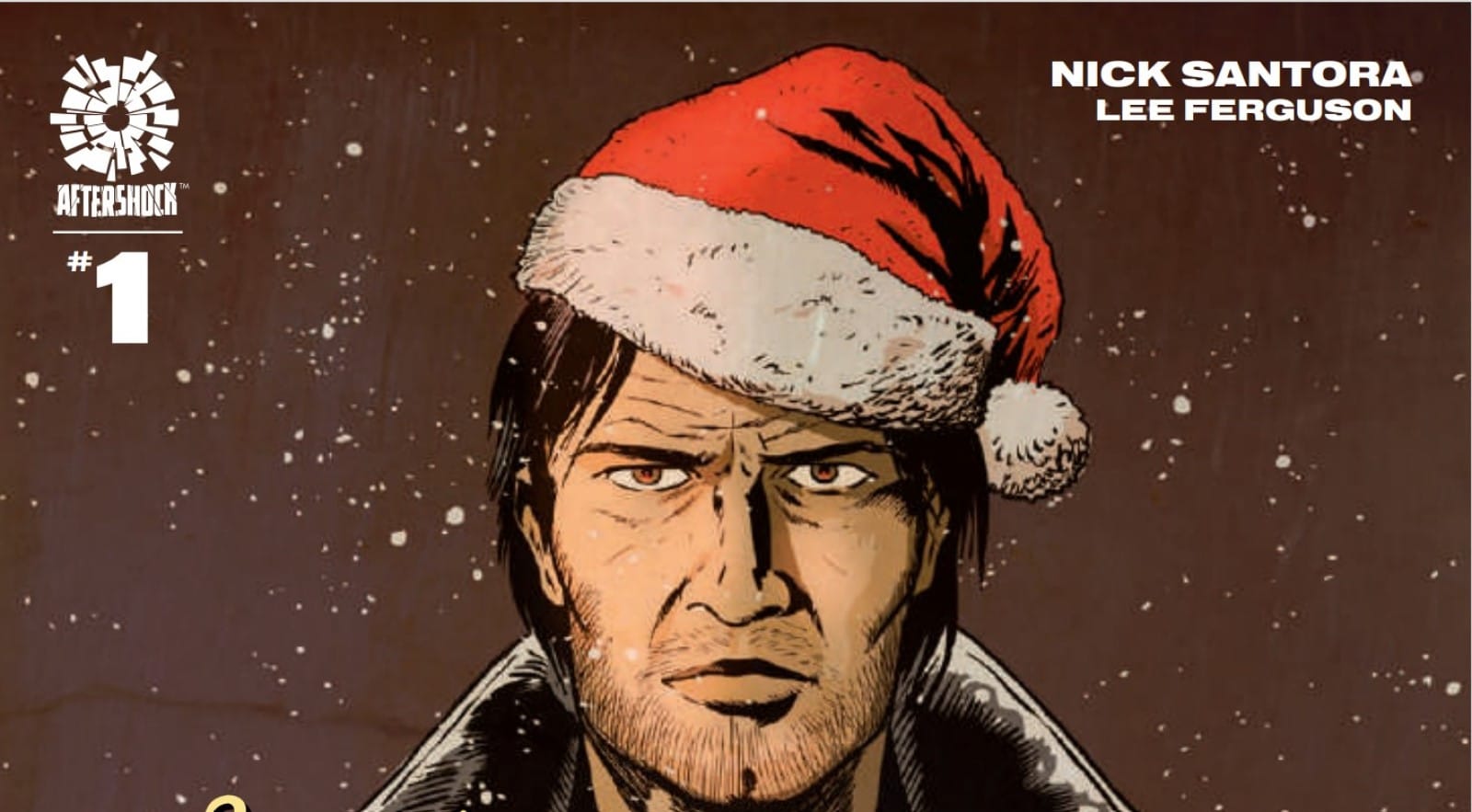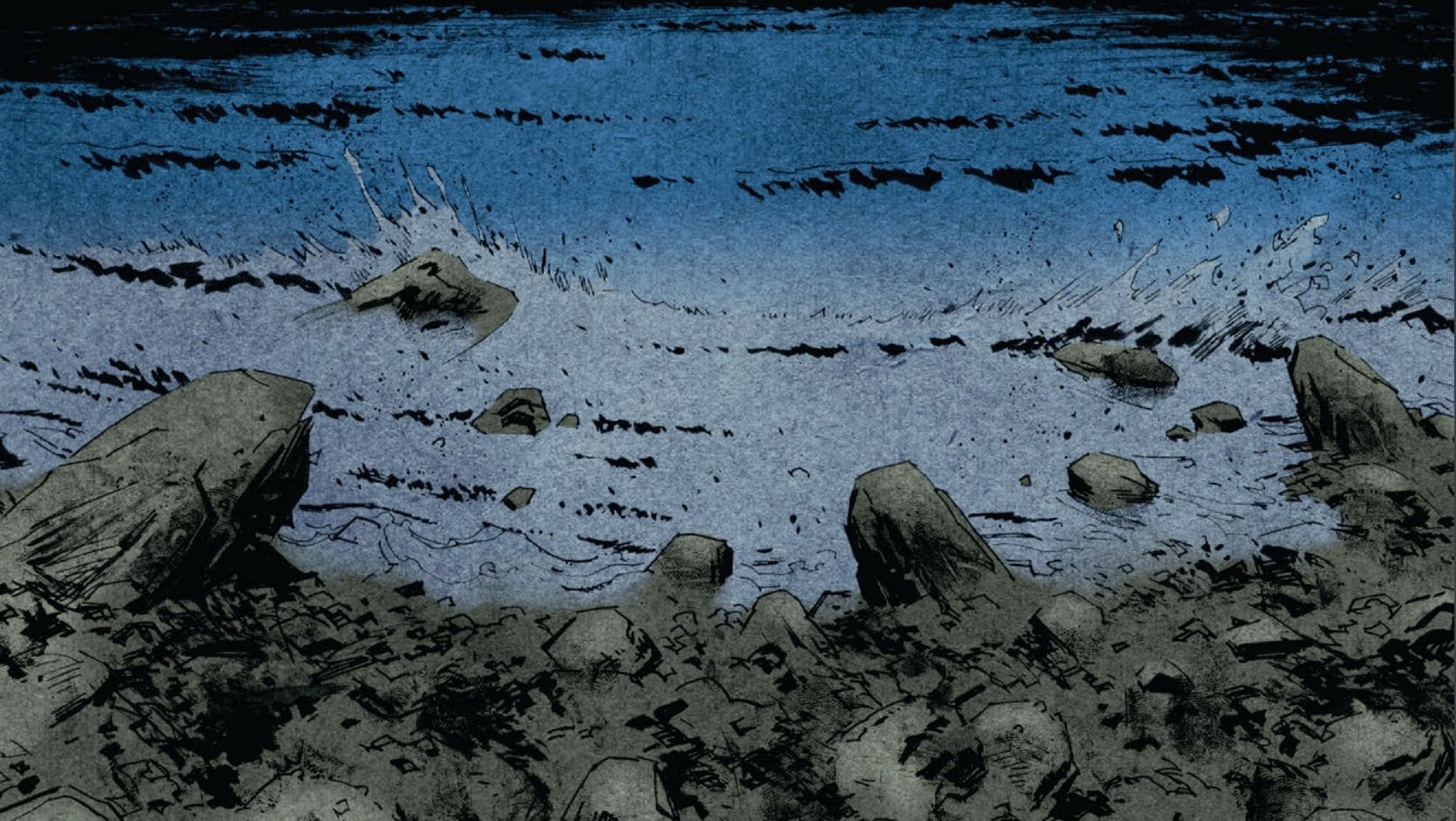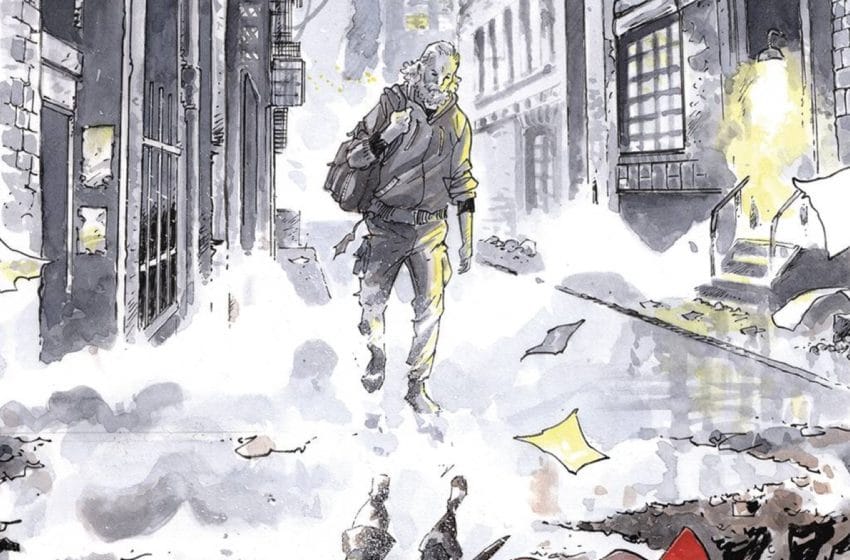Sometimes dead is better. Especially when you’re trying to hide a trio of corpses in Dogs of London #1, written by Peter Milligan, drawn by Artecida, colored by Valentina Bianconi, lettered by Rob Steen and published by AfterShock.
The only thing harder than an art heist during a monster attack is stealing gold from the belly of an elder god. Shit, that sounds really hard. Kaiju Score: Steal from the Gods #1 is written by James Patrick, drawn and colored by Rem Broo, lettered by Dave Sharpe and published by AfterShock.
If Santa is pissed because someone stole the thing that helps him keep track of who he’s pissed at, can he even really be pissed? That deep thought and more in Naughty List #1, written by Nick Santora, drawn by Lee Ferguson, colored by Pippa Bowland and Juancho!, lettered by Simon Bowland and published by AfterShock.
Will Nevin: Say, Ian, what do you think about AfterShock as a publisher? Any of their series stick out to you as a favorite?
Ian Gregory: AfterShock has put out some books I’m a really big fan of, like the various Thompson and Nadler series (I Breathed A Body, Lonely Receiver, Undone by Blood) but also a fair bit of ones that have missed the mark — including a few we’ve reviewed in this column, like Bylines in Blood and Chicken Devil. It is both to their credit and to their detriment that they have a very specific editorial direction.
Will: By “specific editorial direction,” you mean weird, high-concept stuff that can flame out just as easily as it can be good? Anyway, I ask, good buddy, because this week is all AfterShock, ‘cuz we are chock full of recent #1s from the company. Time for a theme week?
Ian: Theme week! Theme week! Theme week!
Dogs of London #1: Confusing with a Side of Not Bad and Cool
Will: Ian, I don’t claim to be the smartest man in the world, but I’ve got 11 years of post-secondary education, four college degrees and I *consistently* make it to the big boy potty on time. I’m a clever guy. But the ending of Dogs of War gave me a brain cramp. So we open the book in 1966 before skipping forward 44 years, right? In those intervening years, our small-time hoods have become upstanding businessmen and veritable pillars of the British Empire. But they’ve still got some secrets, including a few pricks they put in the ground back in ‘66.
Here’s where the cramp comes in. Our lead character is told about three bodies turning up … and these are his first thoughts:
Again, I’m no genius, but I’ve got a few things going on upstairs. This here? Makes no sense to me. Yes, I get the overall idea (these corpses turn up and look fresh, probably owing to some weird science or supernatural forces) but why does our guy seem to think that corpses age? Did I miss something here, or is this a book explaining its conceit poorly?
Ian: I’m with you on this — I had the exact same thought. It’s a disconnect between “the people were estimated to be in their 20s when they died” and “the bodies are estimated to have been there for 30 years.” It’s just a minor grammatical issue, because the premise comes through fine, as you say. But it definitely threw me for a bit of a loop.
Will: Aside from the bit that made my brain space go “owie,” I thought this was mostly fine stuff — probably too many characters and relationships to get going in the first issue, but this team probably doesn’t have a lot of real estate to play with. What did you like here?
Ian: Maybe it’s because I’m a filthy American, but I always thought the British mob scene was really interesting. The imagery of the ’60s comes through really well in this book, with our characters strutting around starting fights in suits.
Will: Mike Myers is working again, so is Austin Powers cool again? But I digress.
Ian: There were a few too many characters to track in this first issue, but I also like the idea that we know where a few of them end up, leaving the reader to wonder what has happened to the rest in the coming 50 years.
I also like this time-jumping setup for what it says about our main character. Mob crime has often been described as parasitic crime — meaning they function only to siphon value from actual laborers. Fifty years later, Frank is a member of England’s upper class, and still just as much of a parasite. There’s a nice thematic link between these two time periods.
Will: If you ask me, I’d say the rich are best eaten with a side of macaroni and cheese to balance everything out. (Kraft if we’re going to be specific.) Of the three books we have this week, I thought the art here was the strongest — rich, moody, engaging. What was your take on the visuals, Ian?
Ian: Artecida’s got a good eye for posture. These characters swagger across the page and fill up every scene. Valentina Bianconi is also doing great work on the colors — the scenes in the ’60s are bright and colorful, but the 2010s are washed out and steely. It would be all too easy to make a crime book like this all grays and blacks, but I like the vibrancy to these pages.
Kaiju Score: Steal from the Gods #1: Oh Shit, We’re Going to Rob an Elder God

Will: It’s a sequel to a series I know we would have covered (crime and weirdness — we’ve got a lane, after all) had we been covering such series at the time, but I believe you wrote about it, correct? I may have done the same, but I confess that I don’t remember much from the original aside from the premise, which, admittedly, is pretty good as premises go. Heists are great. Kaiju are great. Putting them together has to be great, right?
Ian: I actually reviewed the first issue of this way back in November of 2020. I was a little worried that the series wouldn’t do everything it could with its premise, but I was ultimately very happy with how the first volume turned out. I’m happy to see that this is one of the few indie series that has survived into a second volume, and that all the character development from the first arc will actually matter.
Will: In my extensive preparation for this column, I flipped through the first issue in the original series, and I will say we’ve got a tiny bit of a Jurassic Park: The Lost World problem that the first one didn’t have: There are no monsters in this book, Ian! Does that mean we can get a refund? Silliness aside, at least this series escalates the premise — no longer are we dealing with “mere” garden-variety godzillas, no. These are goddamned ancient gods. Way to raise the stakes, eh?
Ian: In a way, I’m worried that raising the stakes will make this book less interesting. What made the kaiju in the original Kaiju Score work so well for me was the focus on their biology and animal behaviors. They were predictable on a macro scale, but unpredictable when they’re staring you in the face. That made their presence in the book a huge wildcard, as they swung between helping out the characters and getting in their way. Here, the kaiju are frozen (and boy, do I not believe they’re going to stay that way) and are significantly more dangerous and mythic. The kaiju in Kaiju Score Vol. 1 were almost approachable — they were a grounded, believable part of life.
Another concern I have is the expanding universe of criminals. The first volume kept things fairly close to the ground: We had our team of four, plus their untrustworthy backer. Now we’ve got multiple crews, multiple crime families and backers, and I’m worried that we’re going to stray too far into crime and too far away from kaiju. The first series hit a very hard balance of keeping both of those elements interesting and relevant, and I worry that that balance will be disrupted here.
Will: Ian, if the monsters in this series stay frozen, I’ll give you my next six ComicsXF paychecks plus the lucky bedpan my pee paw left me. I said the art in Dogs of London was the strongest this week, but maybe that was a bit unfair. I think this is every bit as good, but certainly different — less of an emphasis on realism, more bombastic colors, you know, the sort of things that are going to make the ancient ones pop whenever we get to them.
Ian: I loved Broo in the first volume, and they’re doing great work here as well. We know from the first volume that the kaiju designs will be on point, so I’m looking forward to seeing what we get in this volume.
Naughty List #1: Santa is Here to Fuck You Up

Will: No brain cramps in this one, Ian, in what had to be the most straightforward thing I’ve read in quite some time. Santa is real; he’s kinda pissed that he’s still alive, but he gets drunk and high with the elves to take the edge off. That was working well until someone stole his (wait for it) naughty list and used it to target the evildoers of the world. It’s not all that complex, but you know, it was a fun read.
Ian: It certainly is 24 pages of setup. I suppose the idea was to set this Santa up as a disillusioned, serious man. But this is basically the setup to the Aardman movie Arthur Christmas — a disillusioned Santa Claus caught up in logistics and endless toy making who has lost the meaning of Christmas. Of course, here, someone steals the Naughty List and uses it to commit murder — but how much use is the naughty list, really? If you were capable of committing all these murders, why do you need a Naughty List to tell you who’s evil and who’s good? Wouldn’t that kind of person be perfectly willing to make those judgments themselves?
Will: Why are you asking questions about the core concept when I just said this was more or less a silly fun book? Still, fuck me, because I couldn’t help reading and thinking about the anachronisms — or at least what felt like anachronisms. Why can’t I enjoy things, Ian?
Ian: There is a weirdness to Santa narrating events from the medieval period from the modern perspective — which includes jokes about Paul Rudd. I was also slightly frustrated by the assertion that people have somehow gotten worse on average, morally, since the 1500s. I really don’t think I need to go into detail about how stupid that idea is, but what really concerns me is that it’s such a strangely conservative notion — that somehow, a more Christian and traditional lifestyle is more morally upstanding.
Will: This was where I thought the art could definitely have been stronger — more details, more vibrant colors for starters. What did you think about the visuals?
Ian: Despite the talk about magic, Santa is so visually unremarkable. He’s just a dude. Maybe that’s the point, but it’s definitely a little boring. The colors are also awfully muted for a Christmas book, even one that’s a subversion. This premise is ridiculous and fun, so give the art some punch!
Does This Smell OK to You?
- Will’s favorite AfterShock books: Hot Lunch Special, Rough Riders, Maniac of New York, Dark Ark and a few he’s probably forgetting.
- Bon Appetit discovered a thing Boy Scouts have known for decades: Eggs taste even better when you cook ’em up in leftover bacon grease.
- If you still have leftover Easter ham, you should probably get rid of it … but next year, think about this pineapple and ham fried rice. (Also, if you consider using Spam in that, Will promises not to judge you.)
- When we stick to horror, crime and crime horror, isn’t every week a theme week?







